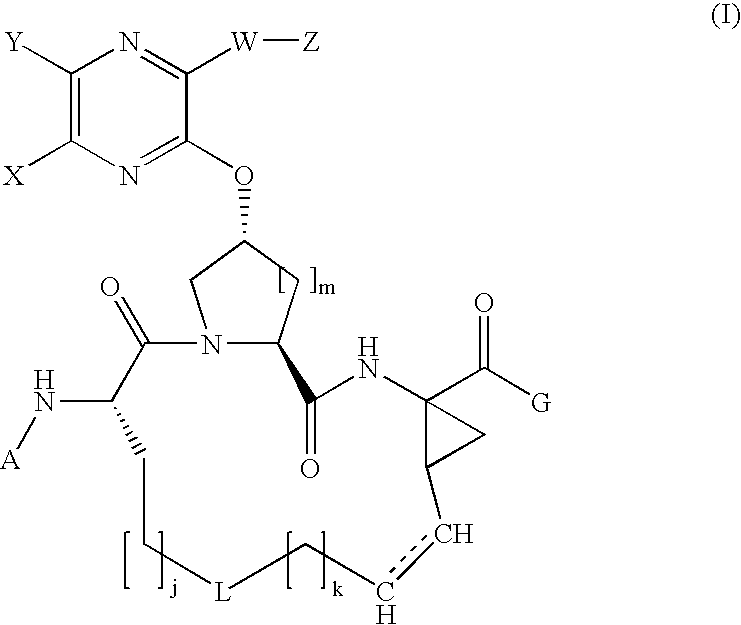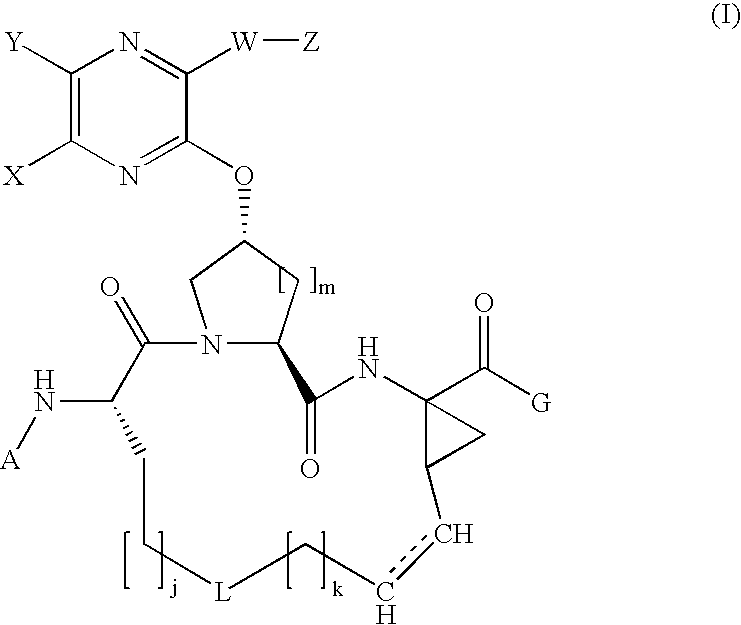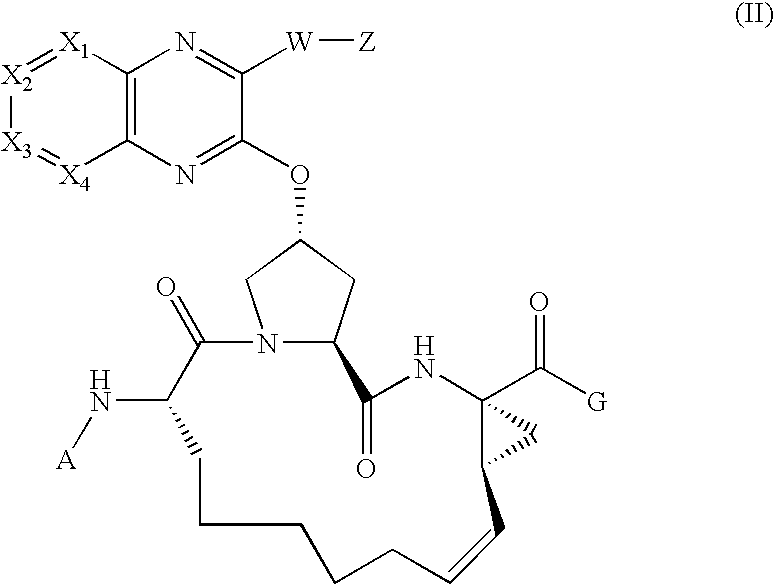Quinoxalinyl macrocyclic hepatitis c virus serine protease inhibitors
a serine protease inhibitor and hepatitis c virus technology, applied in the field of macrocyclic compounds, can solve the problems of interferon related side effects, inability to reproduce infectious culture systems and small-animal models of hcv, and increasing public health problems, and achieve the effect of inhibiting serine protease activity
- Summary
- Abstract
- Description
- Claims
- Application Information
AI Technical Summary
Benefits of technology
Problems solved by technology
Method used
Image
Examples
example 1
Synthesis of the Cyclic Peptide Precursor
[0269]
[0270]1A. To a solution of Boc-L-2-amino-8-nonenoic acid la (1.36 g, 5 mol) and the commercially available cis-L-hydroxyproline methyl ester 1b (1.09 g, 6 mmol) in 15 ml DMF, DIEA (4 ml, 4 eq.) and HATU (4 g, 2 eq) were added. The coupling was carried out at 0° C. over a period of 1 hour. The reaction mixture was diluted with 100 mL EtOAc, and directly washed with 5% citric acid (2×20 ml), water (2×20 ml), 1M NaHCO3 (4×20 ml) and brine (2×10 ml). The organic phase was dried over anhydrous Na2SO4, filtered, and then concentrated in vacuo, affording the dipeptide 1c (1.91 g, 95.8%) that was identified by HPLC (Retention time=8.9 min, 30-70%, 90% B), and MS (found 421.37, M+Na−).
[0271]1B. Dipeptide 1c (1.91 g) was dissolved in 15 mL of dioxane and 15 mL of 1 N LiOH aqueous solution, and the resulting mixture was stirred at room temperature for 4 hours. The reaction mixture was acidified by 5% citric acid and extracted with 100 mL EtOAc. Th...
example 2
Compound of Formula IV, wherein
[0275]
[0276]Step 2A.
[0277]To a cooled mixture of macrocyclic precursor 1, 3-(thiophen-2-yl)-1H-quinoxalin-2-one 2a (1.1 equiv.), and triphenylphosphine (2 equiv.) in THF was added DIAD (2 equiv.) dropwise at 0° C. The resulting mixture was held at 0° C. for 15 min. before being warmed to room temperature. After 18 hours, the mixture was concentrated under vacuum and the residue was purified by chromatography eluting with 60% EtOAc in hexanes to give 2b as a clear oil (35 mg, 99%).
[0278]MS (found): 704.4 (M+H).
[0279]H1-NMR [CDCl3, δ (ppm)]: 8.6 (d, 1H), 8.0 (d, 1H), 7.8 (d, 1H), 7.6 (m, 2H), 7.5 (d, 2H), 7.2 (t, 1H), 7.0 (brs, 1H), 6.0 (brt, 1H), 5.5 (m, 1H), 5.3 (brd, 1H), 5.2 (t, 1H), 5.0 (m. 1H), 4.6 (brt, 1H), 4.1-4.3 (m, 3H), 3.1 (m, 1H), 5.3 (m, 1H), 2.1-2.3 (m, 2H), 1.3 (brs, 9H), 1.2 (t, 3H).
[0280]Step 2B.
[0281]A solution of compound 2b and lithium hydroxide (10 equiv.) in THF / MeOH / H2O (2:1:0.5) was stirred at room temperature for 20 hours. The ...
example 3
Compound of Formula IV, wherein
[0285]
[0286]Step 3A—Amine deprotection.
[0287]The title compound of Step 2A (82 mg, 0. 116 mmol) was treated with HCl (4 M in dioxane, 3 mL, 12 mmol). The reaction mixture was stirred at room temperature for 2 h until LCMS showed the complete consumption of starting material. The solvent was removed in vacuo.
[0288]Step 3B—Chloroformate Reagent
[0289]The chloroformate reagent 3b was prepared by dissolving 0.22 mmol of cyclopentanol in THF (5 ml) and adding 0.45 mmol of phosgene in toluene (20%). The resulting reaction mixture was stirred at room temperature for 2 hours and the solvent was removed in vacuo. To the residue was added DCM and subsequently concentrated to dryness twice in vacuo yielding chloroformate reagent 3b.
[0290]Step 3C—Carbamate formation
[0291]The resulting residue from step 3a was dissolved in DCM (3 mL) then treated with cyclopentyl chloroformate prepared in step 3b (0.22 mmol) and iPr2NEt (0.35 mL, 2 mmol). The reaction mixture was st...
PUM
| Property | Measurement | Unit |
|---|---|---|
| temperature | aaaaa | aaaaa |
| temperature | aaaaa | aaaaa |
| emission wavelength | aaaaa | aaaaa |
Abstract
Description
Claims
Application Information
 Login to View More
Login to View More - R&D
- Intellectual Property
- Life Sciences
- Materials
- Tech Scout
- Unparalleled Data Quality
- Higher Quality Content
- 60% Fewer Hallucinations
Browse by: Latest US Patents, China's latest patents, Technical Efficacy Thesaurus, Application Domain, Technology Topic, Popular Technical Reports.
© 2025 PatSnap. All rights reserved.Legal|Privacy policy|Modern Slavery Act Transparency Statement|Sitemap|About US| Contact US: help@patsnap.com



